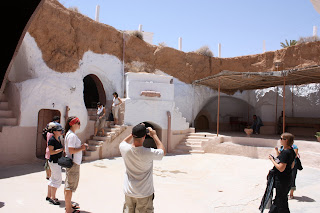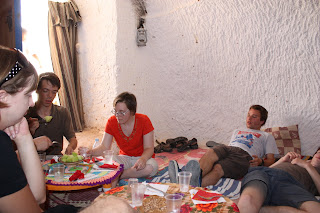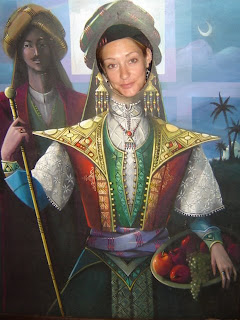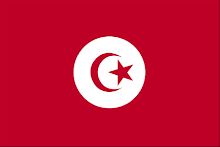Three months since I returned from Tunisia, having suddenly dropped off the face of this blog, I thought I might-as-well close it properly. In essence, I became utterly consumed in the final mad dash of Arabic language insanity as ew finished our last few weeks in Sidi bou Said. It was intense, stressful, and utterly rewarding. I am currently looking for a way to continue my Arabic while living here in Atlanta and working at the CDC.
I would absolutely jump at the chance to do this program again, especially now that I know what to expect. And I LOVE being able to understand the bits and pieces of Arabic I hear now in the movies and on television. And of course, I really miss Tunisia and the friends I made while there.
Monday, November 9, 2009
Friday, July 10, 2009
Excursion part 4: Day 3; underground houses and amazing Ksars


After our amazing night in the desert we crossed the width of Southern Tunisia, stopping at numerous sites to gape at the unreal traditional architectural characteristics of the arid region including troglodyte (underground) houses, semi-troglodyte (built into the side of a hill) houses and the fortified graneries called Ksars.
Before arriving at our first real stop we made a quick break at an overlook at Tamezret, which overlooks the Nefzaoua valley and shows the incredible terraced agriculture employed to limit erosion and capture all possible water. It reminded me so much of the rice terraces of the Philippines and Laos - minus any greenery.



The troglodyte houses in this region are stunning. From above these troglodyte houses resemble bomb craters. Berbers developed these naturally temperature-controlled structures. The brilliance of digging a house underground or into the side of a hill is not to be missed: the desert naturally lacks such building supplies as wood with which to build, but far more importantly, digging one's house underground utilizes nature's natural heating and cooling systems. In the summer, the ground underneath the scorching sand stays cool, having retained the previous night's lower temperature and of course avoiding direct exposure to the sun. In the winter (the desert gets very cold) the underground houses retain the summer's heat.


We viewed a number of these troglodyte houses in Matmata, a village of about 100 people made famous for being the setting for the home planet of Luke Skywalker . We stopped at Hotel Sidi Driss which became a hotel after its use in Star Wars (and if for some crazy reason you went there without knowing this it has plenty of signs - such as a very tacky old Star Wars towel tacked up on a wall). It has five pit courtyards connected by underground tunnels.

Next we went to Medenine to see one of the best Ksars in in the region. A Ksar is a Berber's traditional fortified grainery that preserves and protects the grain crops produced in good seasons. Each Ksar has many ghorfas (literally translates in Arabic to "rooms"), long, narrow cave-like rooms that house the grains. Each family in the village would have a ghorfa. A caretaker (usually a religious figure in the community) would regulate the amount to be taken out by the owners during times of scarcity and in this way the Ksar acted as a "food bank." The ghorfas are stacked 3 and sometimes even four high, with crazy stone stairs built to reach them. A pulley system was used to raise and lower the grains from the higher rooms.


The Ksar was one of the craziest looking structures I've seen, and it was easy to fantasize that these were actually dwellings rather than food storages (and thus they have been represented in movies as desert dwellings rather than as boring food houses).

As there was a clear shortage of buffet-style feeding options for 45 tourists, our guide had arranged for an amazing lunch served in a traditional Berber troglodyte bed and breakfast (I know, right!). We ate a regional meal of lamb, cous-cous, salad and plenty of fruit, after which we were stuffed (due to the insistence of the matriarch feeding us). The woman and her children who lived there were very funny, speaking little English but more than happy to gesture wildly. as there were far more of us than there were cave dining rooms, I ate lunch with a small group on the floor of one of the bedrooms, and promptly passed out for a brief nap afterward.


After lunch we once again piled into the bus and made our way to the east coast and over a long bridge to the island of Jerba - the Land of the Lotus Eaters in Homer's Odyssey, in which the crew didn't want to leave after drinking the sweet beverage (the same one I had tried to days earlier back in Tozeur I mentioned in that blog).
We were set up in a very nice hotel and I immediately headed for the beach, where I was able to do one of my favorite things in the world - riding a horse on the beach.


Wednesday, July 8, 2009
Exursion part 3: Day Two part 2: not-quite-roughing-it in the Desert


So we had been told we would be going on a camel trek into the desert where we would be spending the night. We had all anticipated that we would be getting on the camels in the midday heat and riding them for a couple of hours. Many of the students were not even sure they wanted to ride camels for various reasons ("they're mean, dirty scary" etc - how could anyone give up such an opportunity?!). So in preparation for such an arduous journey, most of the students went out during our earlier excursions and bought these hilarious straw hats (imagine 20+ students with these identical hats) and many bought traditional desert garb to fully cover themselves and protect from the midday heat.

Now if you read the previous blogs of earlier this same day, you will note that we in fact did a zillion things that day, and did not arrive to our camel-mounting location until 7pm, by which time the sun was of course setting, the air was cooling off and there was no need for the ridiculous hats and clothes everyone had purchased (having done a two-day scuba-diving camel trek in Egypt last year I had brought a hat with me...I win!) To add to the insult, the "great camel trek" that had been built up in many of the students' minds to be an epic desert adventure turned out to be a 25 minute ride to our desert camp, complete with toilet and shower facilities and AIR CONDITIONED TENTS. Did I mention that we had young men leading our camels on foot? Too funny. (I'm so glad i had the "authentic experience in Egypt.")


Nonetheless, I was not about to complain for having decent toilet facilities, a tent in which I would not be tossing and turning on a floor as I sweat profusely, and a "bar" providing hookas and beer. The scene at dusk was unreal - a desert camp surrounded by sand dunes.



We settled in in time for an incredible (well recreated yet touristy) performance of traditional dance and music which was fabulous, and a dinner that included lamb straight off the giant spit next to the mess hall/ outdoor seating. The stars were truly incredible and the sand the softest I have ever felt- like heavy dust - and I spent a therapeutic and self-reflective hour by myself that night sitting on the top of the dune letting the sand fall between my fingers.

The next morning we arose early for some picture-taking (by the end of which over half of our cameras broke from the blowing sands, including mine), dune-exploring and a light breakfast. We then piled onto a number of horse-drawn carts and were whisked away over the alternative desert trail used to haul supplies into the camp and back to our awaiting bus.



This was an amazing night - even if it was not "authentic." I have embrace being a tourist on these weekend excursions as I would not have been able to afford or put together such extensive trips.
Sunday, July 5, 2009
Exursion part 3: Day Two part 2: A whole new world?


After our lunch we began slowly making our way across Tunisia towards the eastern coast. Our first stop was at Sidi bou Hlel, a stunning mosque perched on a mountain cliff overlooking "Star Wars Canyon," so called for the numerous scenes filmed there. Besides the canyon, it had a stunning view looking out towards the salt lake, which you can see in the horizon.

Just before dropping down into the salt lake we stopped at the top of a mountain range for a great panoramic view of Tamerza - one of the oldest villages in the area with a gorgeous backdrop of a mountain. From the view one could see the 1000 year-old abandoned houses that formed the original tiny village, with the newer houses (though still centuries old) surrounding it.

We then crossed the Chott el-Jerid: an immense salt lake covering 5000 sq km (one liter of water gets you a KILO of salt) that was for me probably the most other-worldly location I've ever been to (which says a lot to me). No wonder it was the scene in the first Star Wars where Luke Skywalker contemplated two moons in the first movie - I wouldn't have been surprised if I'd seen five moons! All the petty things in life seem so trivial in that environment, both in a spiritual and survival sense. The mirages were crazy and the heat and sun somehow different from anything I've experienced.



On the other side of the salt lake we stopped at a an amazing little are in the town of Blidet where the sand had blown and harden into incredible shapes, some like mini sand dunes and others like termite mounds. In the middle of it all was a small traditional thatched building that acted as a cafe and souvenir shop. The man was very friendly and had a gorgeous falcon named Jorge with whom I quickly became close with (I think Jorge pooping while perched on my arm must mean he really felt comfortable around me...). The man actually sells gorgeous postcards of him dressed in traditional desert garb with his falcon.



Then we were off to our final destination of the day: a camel ride to a tent camp in the middle of the sand dunes!
Friday, July 3, 2009
Exursion part 2: Day Two part 1: Tozeur part 2: The Oasis

As if we hadn't done enough before lunch already, we now went on a fabulous tour of the Tozeur oasis (palmerie). It is the second largest in the country with over 200,000 palm trees covering 10 square km. It was truly an amazing sight to crest a hill in the desert and suddenly see a giant forest of palm trees ahead when we arrived the evening before.

We all climbed into a number of horse-drawn carriages (some horses looked like they might not make it...) and went on a lovely ride weaving around the corridors. We learned that each family in Tozeur (most are able to afford it) has their own small plot and gets their turn to water it every four days, for a price of about $400 USD per year for the water. The land is brilliantly farmed with three levels of agriculture: the palm trees up high soaking up the sun, the fruit trees below them (lemon, banana, pomegranate, grapefruit, lime, plum, almond....) and various vegetables growing on the ground.


Farming the date palms is very labor intenseive: every female date tree is pollinated by hand by sticking the pollen from a male tree (one male date tree can pollinate over 100 female ones, hence there are 10 female trees - since they are the ones bearing fruit - for every one male) into the top of the female tree where the fruit will form and tying it together with a slice of the palm leaf. To do so, young men climb every one of these female trees, taking about two months to complete. Apparently the yield increases 10-fold by pollinating using this method - 10 kilos per tree of delicious dates! (I'd actually never had one before and think they look and taste exactly like caramels...mmmm)

Wednesday, July 1, 2009
Exursion part 2: Day Two part 1: Tozeur part 1: Medina, Museum & Zoo

From this title you get the feeling that I had a jam-packed weekend...I began day two with an early morning tour of the Tozeur Medina (walled city). This was definitely the most authentic of the medinas I'd seen: still in use by the people who live there and with relatively few touristy shops.


We came across an amazing antique shop that had among other great finds these incredible ornate wood and brass traditional coffee grinders that must be at least one hundred years old.


Just outside the walled city we stopped to try the mythical yet real concoction portrayed in Ulysses' Odyssey: the liquer that was drank in the Land of the Lotus Eaters (which is in fact the Island of Jerba where we spent the following night- more on that to come) and caused the men to never want to leave. It is a slightly alcoholic beverage made of fermented date juice - it didn't taste too bad actually, though I didn't care for more than a sip (so I guess I won't be living here forever:)

Just behind me in the pic you'll notice some animal-material-looking dark bags - they are goat skins that hold cold water; it was unreal to feel how cold the bags were, although the water inside was a bit sweet in a not-sugary way...
Next we visited the rather amusing Dar Charait Musuem, a reproduction of a palace that houses a hodge-podge of artifacts and wax figures arranged in scenes of everyday household activities.

Our last stop before lunch (phew!) was the obligatory Tozeur Zoo with the usual sad-looking animals - mostly camels, birds and reptiles. The camels performed the requisite tricks such as the popular "drink a Coke/beer/anythingliquid trick:

Subscribe to:
Posts (Atom)

